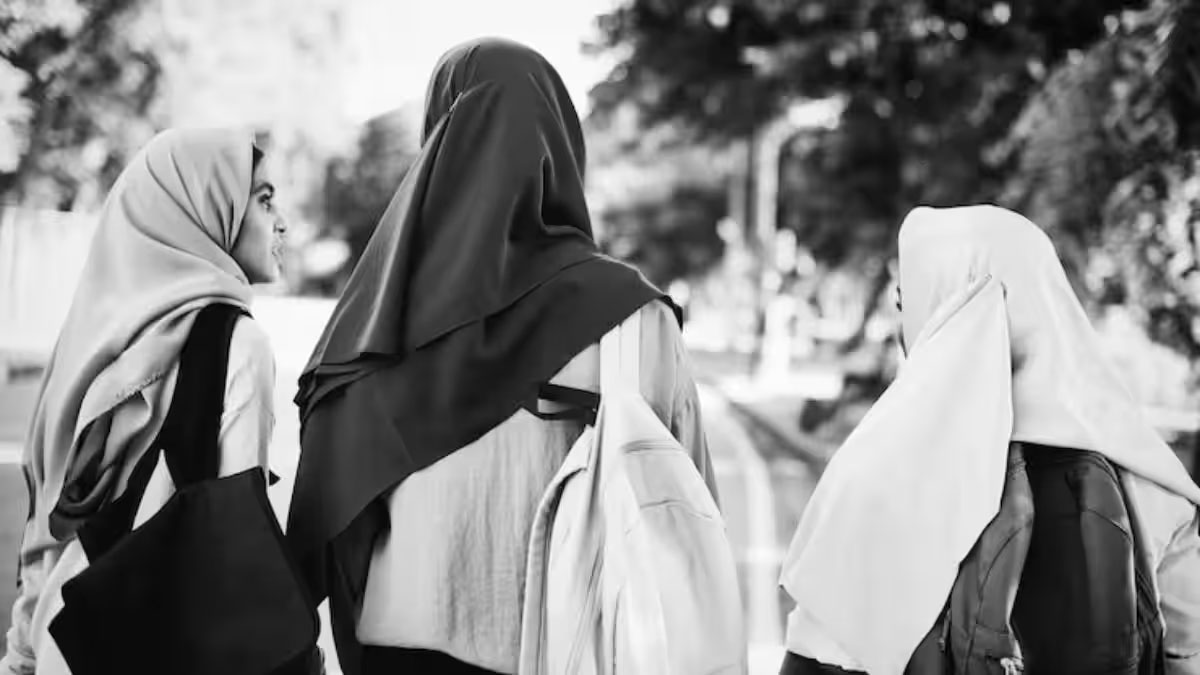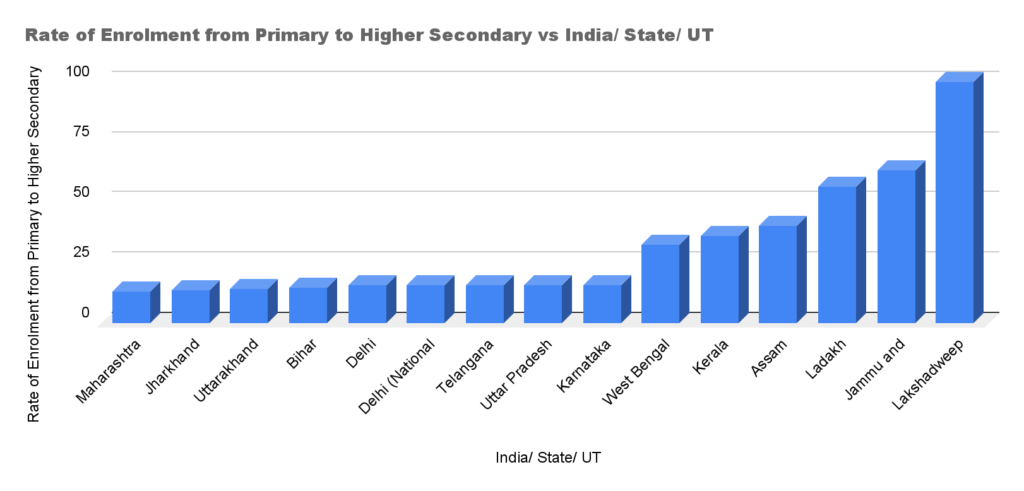According to a recent report titled, “The State of Muslim Education in India” authored by Arun C. Mehta, figures paint a grim picture for social and economic mobility amongst Muslims. Arun C. Mehta is a former professor at the National Institute for Educational Planning and Administration, published the report, based on AISHE and UDISE data, which features a foreword by Najma Heptullah, vice-chancellor and educator at Jamia Millia Islamia. He was also part of the team that analysed the data in the UDISE report for 2021-2022.
The UDISE+ an application by the Ministry of Education for gathering data from both schools across all education levels, from pre-primary to Class 12. This resource offers data on enrolment and dropout rates, teacher numbers, as well as infrastructure details such as toilets, buildings, and electricity in schools. The latest report for the years 2021-2023 has revealed troubling details regarding the presence and absence of Muslims in education.
In June, 2023, Sabrang India had analysed similar trends for the last few years, highlighting the declining figures of Muslim students in Higher Education in India, based on a then newly released data for the years 2019-2020 by the All India Survey on Higher Education (AISHE). The report detailed that although India saw an improvement in educational indices of Dalits, Adivasis, and Other Backward Classes (OBCs), there was steady decline in the enrolment of Muslim students. Currently, Scheduled Castes and Scheduled Tribes constitute 14.7% and 5.6% of the total enrolment, respectively, while OBCs make up 37% of the student population. In stark contrast, Muslim students account for only 5.5% of the overall enrolment, with other minority communities comprising 2.3%.
Significant drop in enrolment to higher education
This time the latest report reveals a decline of more than 8.5% in the enrolment of Muslim students aged 18-23 years, in higher education. While the enrolment of Muslim students in higher education showed an increase from 17,39,218 in 2016-17 to 19,21,713 in 2020-21, a significant dip has been witnessed in the academic year 2020-21, with the enrolment declining to 19,21,713 from about 21,00,860 students in 2019-20, reflecting a decrease of total 1,79,147 students, according to the report.
Furthermore, from the figures below that feature in the report, we can understand that the enrolment percentage is highest at the primary level, from grades 1 to 5, with 15.6%, showing a substantial presence of Muslim minority students in the early stages of education. However, the data shows that as Muslims students move to the upper primary grades, there is a slight but continuing decline to 14.4%, which goes further and sees a deeper dip in secondary education, the pivotal grades 9-10, with a further decrease to 12.6%. This trend of declining Muslim students continues into higher secondary education, where the enrolment percentage drops sharply to 10.8%.
Data from across states reveals that Assam (29.52%) and West Bengal (23.22%) record high dropout rates among Muslim students, while Jammu and Kashmir records a 5.1% dropout rate, and Kerala records 11.91%.
Percent Share of Muslim Enrolment at Different Levels of Education 2012-13 to 2021-22
(Figure 1 Data from the report by Arun C. Mehta)
Furthermore, the report observed key trends across states and Union territories on the decline in enrolment percentages of Muslim students especially in grades 11 and 12.
Percentage of total enrolment of Muslims students in school education across India.
(Figure 2 (UDISE+ data)
Lowest 20 states and union territories with percentage of rate of enrolment from primary to secondary education.
Figure 3 (UDISE data)
The report further highlights the fact that all States and Union Territories show ta lower percentage of Muslim students enrolled in higher secondary education (Grades 11 and 12) as compared to other educational levels. This, according to the report, highlights the need for a targeted efforts to address this issue and ensure better opportunities for Muslim students in higher secondary education in particular. This pattern thus implies that while many Muslim children enrol in primary education, but not in secondary, thereby there is a certain level of dropouts and discontinuation by students in the higher levels.
Furthermore, a cursory look at the bottom 20 states and union territories shows us that states such as Madhya Pradesh, Tamil Nadu, Gujarat, and Goa and even Andhra Pradesh fall in the lower ranges of enrolment in higher education.
Even union territories, including the national capital, show dismal figures with Delhi at 15.4%, Chandigarh and Puducherry at 5.3% and 8%.
Below is the list of top 15 performing states. As we can see the list starts with Maharashtra, having a total percentage of 13% enrolment, against national enrolment rates, from primary to secondary education. Highest on these indices remain the union territories of Jammu and Kashmir and Lakshadweep Islands with 62 % and 97.9 % respectively.
Gendered rate of enrolment in Muslims
According to the report, the proportion of Muslim girls’ enrolment to total enrolment has declined at the primary and upper primary levels from 60.64% to 52.02% and 24.92% to 26.31%, respectively, over the period from 2012-13 to 2021-22. However, interestingly, there is an upward trend at the secondary and higher secondary levels, which increased from about 9.93% to 13.27% and 4.51% to 8.40%, respectively. The report suggests that a similar trend is visible in boys’ enrolment rates. The report identifies retention of students in the education system as a key problem, and recommends, “Promoting retention and completion of each educational level is crucial to ensure a more efficient and inclusive education system. Next, we look at the Muslim enrolment by gender, presented in Tables 11 & 12.”
What are the factors that contribute to these declining figures?
As per the Sachar Committee’s findings, student enrolment in schools is influenced by factors that are not restricted to economic conditions, including overall security and societal harmony, local development and parental educational background. State-level disparities are evident in the availability of educational facilities in villages with a high Muslim population. For instance, West Bengal and Bihar each have about 1,000 such villages, while Uttar Pradesh tops the list with 1,943. In housing and hygiene, a smaller proportion of Muslim households live in sturdy houses, and approximately half lack access to toilets. Additionally, access to amenities like tap water, electricity, and safe drinking water is comparatively lower among Muslims, especially in villages with a high Muslim concentration, compared to the national average (SCR, 2006).
It is also not unimportant to factor in the systemic discrimination faced by the community that has deteriorated into outright public slurs and even hate speech and physical targeting. Apart from overall economic indicators, such prevalent conditions are not conducive for enrolment and engagement in education.
Related:
Denial of access: number of Muslim students shows sharp decline: India
UP: School question paper, on ‘Indian Muslim Terrorism’, calls for India to prepare for war with Pak



